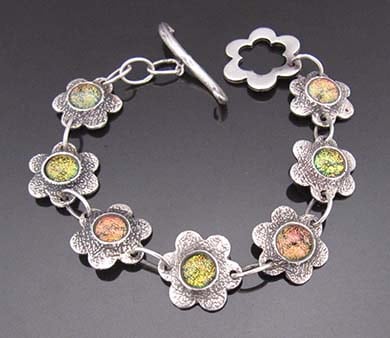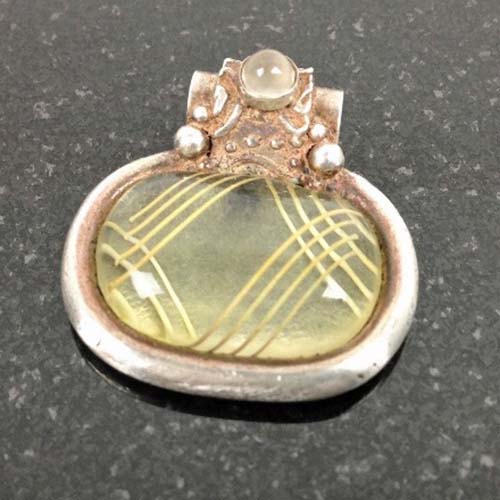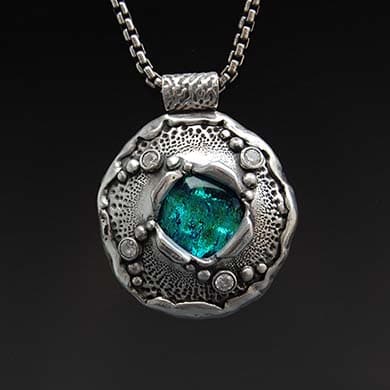Metal Clay and Glass
Many people include larger gemstones in their metal clay by using bezel sets. Glass cabochons can be set this way as well, but glass can also be directly placed into several forms of silver metal clay.
Not just any silver metal clay will do. It must be .999 fine silver and be able to sinter at different temperatures. PMC3, PMC Flex, Art Clay Silver 650, and Aussie Metal Clay 999 are four versions that will allow you to experiment with adding fused glass cabochons to your work. Other silver options may work as well, but shrinkage rates over about 12% will push the glass up over the edge of the silver clay. Since glass is part of the equation, the silver needs to sinter between 1250˚F /676˚C and 1350˚F /732˚C and hold for longer than usual for those temperatures. This firing method keeps the glass stable and does not allow it to melt and flow.
Tracey Spurgin, Glass and Silver Bracelet
A small glass pendant using the minimalist method of a coil around the glass with a completely open back, and an embellished bail with a bezel set moonstone.
Lisel Crowley, Nouveau Necklace
The Minimalist Method
There are two distinct methods for including glass with silver clay. As it uses less clay, the minimalist method is considered high-fire at 1350˚F /732˚C, with a hold of 30 minutes. This high-fire method allows the glass to move slightly but requires that the metal clay is only around the glass edges, not behind or over the surface, or the glass will crack. The second method is considered low-fire at 1250˚F /676˚C, with a hold of two hours. The silver clay must physically catch the glass in this method, which uses a backplate and more silver clay along the front.
In the minimalist method, glass cabochons are captured around the edges with a coil or slab of clay with the cabochon’s shape cut out. The piece must remain flat, with the bail added after it is in the leather hard stage, or greenware stage, along the top surface. The bail is used to reinforce the connection if a coil of clay is used. This style has little texture on the clay and is there to contain and enhance the glass. If using the slab technique, more clay is needed, and adding textures is easier. It is essential to reinforce the coil’s connection since this is the weakest place, and during shrinkage, the glass could push the silver frame open.
The firing schedule for the minimalist method:
ramp 1: 800˚F/ 427˚C to 1350˚F/732˚C, hold for 30 minutes, ramp 2: full ramp to 900˚F/ 482˚C, hold for 30 minutes. This is an annealing stage, glass needs to slowly come to the same temperature even if annealed during the cabochon construction, let the kiln cool to room temperature before opening or the glass may crack.
The Low-fire Method
The low-fire method allows for more work on the silver setting. In this method, a slab is rolled out larger than the glass and cut as a glass frame. A small cutout behind the glass itself, similar to azure for gemstones, allows the glass to move if necessary. Clay is then rolled and cut to lay over the glass cab, either completely with a cutout for the glass to show or prongs to hold the glass in place. This method allows the silver as well as the glass to be center-stage. The bail may be added at any time and can even be integral to holding in the piece of glass. Using this method uses much more silver clay.
The firing schedule for the low-fire method: ramp 1: 800˚F/ 427˚C to 1250F/ 677˚C, hold two hours, ramp 2: full ramp to 900˚F/ 482˚C, hold for 30 minutes, let the kiln cool to room temperature before opening.
The glass must be fired on some surface so that it will not stick to the kiln shelf. Use Bullseye Thin-Fire paper or an equivalent to cover the shelf, or at least under the piece that is firing, if only one piece is in the kiln. This thin-fire paper becomes a powder at the end of the firing. Take care not to breathe in this powder when removing the piece from the kiln. To remove the powder, cover with a damp paper towel and slide in the trash, or dispose of outside in the trash. Seldom is the paper reusable.
A pair of earrings using the low-fire method, with a solid back (with a small cutout behind the glass) and silver clay overlaying the cabochon.
Stephanie Chavez, Eye of the Ocean
During the construction of the silver clay around the glass, use general metal clay techniques. Be sure to clean as much as possible and smooth edges before the firing process. Additionally, any silver or silver slip on the glass’s surface will fire in place, usually creating an unwanted effect. Use alcohol and a swab or piece of paper towel or clean paintbrush to clean all the glass surfaces just before placing them into the kiln to ensure this doesn’t happen.
Some glass will react with silver in the kiln. Sometimes this is on purpose, but often the user can be disappointed with the finished result. You can eliminate this issue by using cabs created with a black base. If you make your cabochons, be willing to experiment with glass to see what effects develop.




